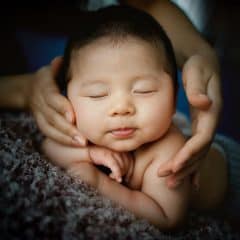Physical Characteristics of Older Preschoolers

Image credit: mcininch / 123RF Stock Photo
Physically, major changes take place from the young 4-year-old to the older 5-year-old. Motor skills, the small muscles of the hands and fingers, as well as the large muscles of arms and legs, become stronger and more coordinated. This allows 5s to complete a variety of physical tasks more easily and with more skill than 4s can generate.
• Basic motor skills (walking, running, throwing, catching, jumping) are developed by age 5. These newly developed skills allow 5-year-olds to begin playing more complex physical games, because their basic motor skills are now automatic. If your class includes 4s and 5s, you will need to play simple games with only a few rules.
• Most children have discovered their dominant hand. In choosing drawing or writing tools, children automatically will use the most comfortable hand. If a child still switches from one hand to the other, don’t worry. This will take care of itself with maturation. Most scissors today can be used by either right-handed or left-handed children. However, older scissors or some metal scissors may be designed to work only for right-handed children unless they are designed for left-hand use.
• Sitting still is more tiring than moving. Ability to pay attention improves greatly during the time from age 4 to 5, but varies greatly from one day to the next. A 10-minute story may be too long one week, while a 25-minute story is just right the next week. Changing weather, holidays, schedule changes and children’s health all affect attention spans. (These things also affect our ability to be patient, so the days they are least able to listen may also be the days we are least able to handle their scattered attention.) While it is tempting to try to keep teaching, once the children are no longer listening, we aren’t really teaching, because they don’t hear what we say.
• Most 4s are beginning to draw representatively, but not photo-like. Some prefer to make patterns. These patterns increase in complexity and show artistic development although they may not appear to be real pictures to adults. For preschoolers, the process of drawing the picture is often more important than the finished product. Often they carefully will draw a picture that we as adults find very satisfying, and then they will just as carefully cover it with scribbles. We don’t need to try to prevent this. The process of drawing the original picture has allowed them to use the art to solidify the concept they have learned. The added layer has allowed them to enjoy the process further and reduced the risk of having made mistakes in their picture that adults might judge.
• The immune system is stronger, but still not powerful. So, the health habits of preschoolers still facilitate the sharing of germs. Children this age focus on their activities to the exclusion of protecting themselves from germs. In their thinking, sleeves are excellent nose wipes, always present and not needing to be thrown away. Therefore, we have to take added responsibility for cleaning toys and tables, providing tissues and trash containers when needed, and reminding children to wash their hands at appropriate times (after toileting, after playing outside, and before and after art activities)
• Preschoolers are still farsighted; close work, especially if print is small, is tiring. Children may be farsighted until they are 6 or 7 years old. Because they tend to assume everyone sees the way they see, they may not realize their near vision is not normal. As a result, we need to make sure that print and pictures they use are large enough to be seen easily by the children.
• Outdoors, 4s and 5s love to create challenges. A playground with too many or too few challenges increases risk of injuries. One of the joys of preschoolers is testing their physical skills. On a well-designed playground, children experience physical challenges without undue safety risks. If the playground is designed for younger children, older preschoolers often create challenge by using the equipment in ways that are not safe. If the playground is designed for older children, they may attempt challenges that are beyond their ability or that cannot be completed safely by a child their size. Always evaluate the size, challenge level and maintenance of any playground you use with preschoolers. If you have 4s and 5s on the same playground, you may need to add simpler or more complex materials to assure safety for both groups. Balls and other loose parts are simple options for accomplishing this goal.
• Five-year-olds begin to skip and whistle. These milestones are exciting to them and worth celebrating.
• Heads are still large in proportion to bodies, making them top-heavy. One teacher tells of asking the children to bow their heads for prayer. One little girl willingly complied and bowed completely off the edge of her chair. Boys often fall out of chairs at this age. For this reason, it is simpler to seat children on the floor unless they are sitting at a table.
Click here to read about Mental Characteristics of Older Preschoolers.



